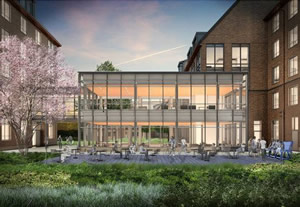Progress Made on Duke University Residence Halls
 Duke University in Durham, NC, recently celebrated the topping-out milestone for the new Hollows Residence Halls on the West Campus. The highest structural feature was placed on the residence halls, which consist of two adjacent six-story buildings.
Duke University in Durham, NC, recently celebrated the topping-out milestone for the new Hollows Residence Halls on the West Campus. The highest structural feature was placed on the residence halls, which consist of two adjacent six-story buildings.
Together, the Hollows will house approximately 500 students in suite-style living spaces. Along with multiple room configurations, they will also feature student lounges, kitchen spaces, study areas, and living quarters for resident advisors.
The Hollows are being constructed by Skanska USA, and have a projected completion date of sometime in 2019.